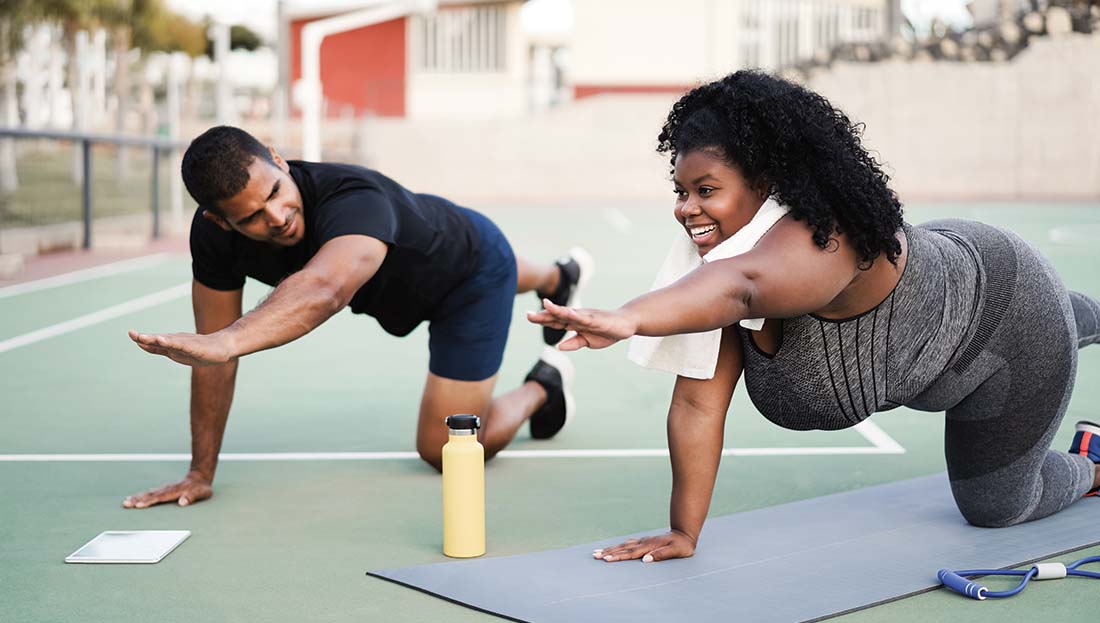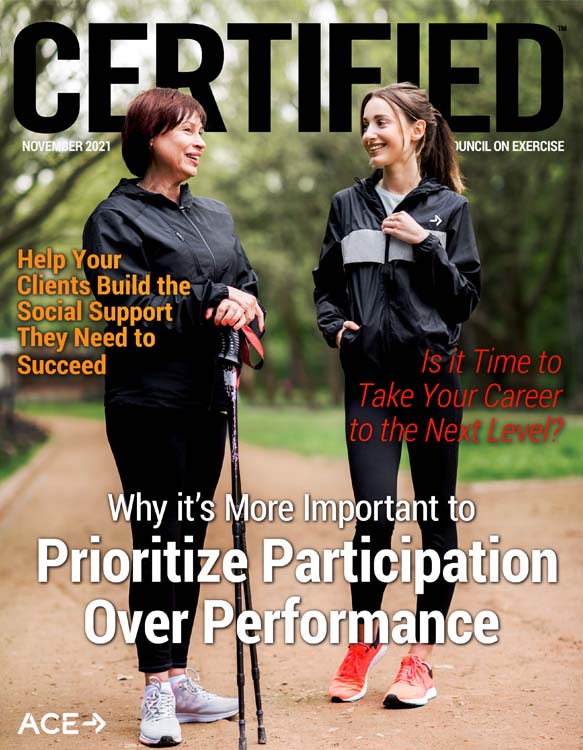
Intensity plays a vital role in progressive exercise programming and in achieving the health, fitness and performance benefits of long-term exercise adherence. ACE has sponsored several research studies on the topic in recent years and published the acronym-laden articles to prove that point—think HIIT, REHIT and EPOC. That said, ACE’s mission is to “Get People Moving,” reflecting the fact that movement of any intensity is valuable and drives meaningful benefits.
As the fitness industry remains in flux, many health coaches and exercise professionals are likely working with clients who want to “get back to normal” and return to the workouts they were performing pre-pandemic as quickly as possible. Unfortunately, performing exercise that is too intense too soon increases the risk of injury, overtraining and program dropout.
Focusing on participation and successful movement—and the physical, mental and emotional benefits of a single bout of exercise—rather than on long-term benefits such as weight loss or improvements in performance, may help people get back on track and reconnect with the reasons why they exercise in the first place.
When working with clients reengaging after the pandemic, convincing them to get back to basics can be a challenge. But, as Chris Gagliardi, MS, Scientific Education Content Manager at ACE and an ACE Certified Personal Trainer, Health Coach, Group Fitness Instructor and Medical Exercise Specialist, explains, helping to set appropriate expectations, emphasizing the joy of movement and empowering clients to achieve early success as they return to their exercise programs can reinvigorate their motivation levels and get them started on the right track.
Anna Woods, ACE Certified Personal Trainer and founder and owner of sheSTRENGTH, says that people are risking serious injury if they push to get back to more intense workouts too quickly after a period of inactivity or reduced activity. Relearning how to perform basic movement patterns, she explains, can help prevent injuries such as plantar fasciitis, low-back pain, knee pain and hip tightness. Nothing derails an exercise program like an injury, so a methodical approach to reengagement in exercise is vital.
Woods uses youth as a prime example of a population of clients who particularly benefit from this approach to training or coaching. It’s much more effective to learn proper movement technique first, she explains, before progressing by adding load or intensity. “When youth learn to move well, the speed, power and strength come as a result later on,” she says, emphasizing the importance of building a proper foundation. It’s important to note that this approach, while common among professionals working with youth, is perfectly suited for just about any client. To reinforce the importance of first establishing proper movement patterns, remind clients that it’s much more fun to start slowly and continue to move forward than to start quickly but then have to move backward before progressing forward again.
When asked about the audience for whom this training or coaching approach might work best, Brett Klika, CSCS, co-founder of SPIDERfit Kids, keeps things simple. “This is what I have come to embrace as my approach, globally,” he says.
Focus on Instant Gratification
There are many benefits to be derived from a single bout of physical activity. Reframing exercise as something the client does to feel better today rather than to achieve some distant objective can be powerful. The “instant gratification” of knowing they’ve achieved success and attained some meaningful health and fitness benefits may be a great source of motivation. So, what are those benefits?
These days, any sense of stress relief is a welcome feeling. As Gagliardi explains, “Even though exercise itself is a stressor, those other ways we express stress will be reduced after a bout of physical activity.” Couple that reduction in stress and anxiety with a sense of accomplishment—“I said I was going to do something and I did it”—and you quickly see how powerful a single movement session can be.
While many clients may return to the gym to “get back in shape” or lose the weight they gained during the pandemic, there are a number of acute physiological responses to a single bout of exercise that you can emphasize in an effort to maximize your client’s motivation. For example, reminding clients that they will have increased energy levels throughout the day and experience a reduction in blood pressure following the workout can be empowering.
Klika, who in addition to working with youth also does corporate consulting, adds cognitive benefits to that list. A reminder that they may have increased focus, better attention to the task at hand and increased memory and creativity hits home for a lot of people.
Finally, the notion that people will simply feel better, function more efficiently and experience less pain should not be minimized. Increased self-confidence and self-efficacy can translate to just about any aspect of life, from being a better employee or boss to being a better spouse or parent. Feeling healthier and more energetic is a huge success.
Woods makes a valuable point when discussing the instant gratification benefits of exercise: Just as with any other element of an exercise program, you must personalize what you emphasize during sessions. For example, one client may respond well to a discussion of the healing and functional effects of exercise, while another may be more interested in the post-workout “muscle pump” they get from resistance training. Some people consider muscle soreness a negative response to exercise, while others love to feel the effects of a good workout when they wake up the next day. Some clients hate to sweat, while others view it as an essential sign of a good exercise session. Be sure to connect the results of the exercise session to each client’s goals and values as you seek to empower them to embrace exercise and establish a new physical-activity habit.
Make the Connection to Motivation and Adherence
Gagliardi suggests that health coaches and exercise professionals encourage clients to think about process goals rather than progress goals—that way, showing up at the gym, attending a class or going for a walk is a victory that builds self-efficacy. “Changing the focus from, ‘If I show up to every session for the next six months, eventually I’m going to hit my weight-loss goal,’” he explains, “to, ‘I’m going to show up today so that I feel better,’ creates a specific, targeted reason to move that day.”
A lot of people have an “all-or-nothing” mentality that leads them to believe that if they don’t complete all their workouts at their programmed intensity, they’re not going to get any benefit or achieve their goals. Nothing could be further from the truth.
Showing up, even if the client doesn’t perform to their maximal capabilities, is an important steppingstone process goal that helps build momentum toward habit formation. Once the habit of going to the gym is firmly established, the focus can move to exercise intensity or progressive training, if that is appropriate or even necessary to achieve the client’s longer-term goals.
“Motivation can come from hitting goals,” says Woods. She suggests collaborating with clients to set small, process-oriented goals and then looking back periodically to point out how much work they’ve put in. Illustrating to a client who might be on a fitness plateau or struggling with motivation exactly how much they have already accomplished can be very motivating.
As Klika says, “It’s very difficult to link current actions to future outcomes.” If a client is exercising to feel better later, that’s a very difficult way to form habits, he explains. As an example, consider the difference between telling a client that exercising three to four days a week for six months will help them reach their weight-loss goal and telling them that bringing healthier snacks to work and going for a walk on their lunch break will give them more energy to play with their kids when they get home and help relieve their stress and anxiety. Both types of goals are valuable and important, but the short-term process goals may help the client stay motivated on those days when getting moving is a struggle.
Help Clients Find Activities They Enjoy
Don’t overlook the importance of the fun factor with any client, but particularly with clients returning to the gym after some time away or coming to the gym for the first time. A few years ago, I completed a year-long lifestyle-change project. As part of that project, I filled out an Exercise-induced Feeling Inventory (EFI) after every workout. (Note: ACE Certified Professionals can access a printable version of the EFI at the top of this page to use with their clients.)
The idea is for clients to measure how they feel after a bout of exercise and then look for trends. The EFI has you rank 12 different “feelings” on a scale of 0 to 4, with 0 meaning you “do not feel” and 4 meaning you “feel very strongly.” For example, after a tough interval-training workout, a client may feel a 3 in terms of fatigue, a 4 in terms of being upbeat, and a 1 in terms of feeling revived.
The hope is that as a person becomes more accustomed to an exercise routine, there will be a shift toward higher numbers on feelings such as happiness, peacefulness and energy. As I reviewed months’ worth of EFIs, I struggled to find the trends. My numbers were all over the place.
Then something caught my eye. My numbers were consistent depending on the type of exercise I was performing. Resistance training typically left me feeling enthusiastic, happy and fatigued. I was tired, but proud of myself and excited about my progress. Meanwhile, I was not feeling very refreshed or peaceful after these workouts.
When it came to hiking, I always felt enthusiastic, upbeat and happy. Over time, I reported less and less fatigue and fewer feelings of being tired. This mirrors the improvements in my physical fitness that I could certainly feel on the trail. Hiking, not surprisingly, consistently left me feeling peaceful and revived.
Finally, gym-based cardio exercise on the treadmill or elliptical trainer left me less enthusiastic and happy and more worn out and fatigued. These numbers improved when I introduced interval training to my routine. Those workouts left me more tired, but way more enthusiastic about my efforts.
Seeing these trends mapped out so clearly made me realize that I should shift more of my workout time to outdoor pursuits that seem to lift my spirits while exercising my body. While your clients may not need to complete the EFI after every workout, it’s a good idea to take stock of how a client feels immediately after different types of exercise and how those feelings change over time, and then modifying the exercise program accordingly.
Having fun, after all, is very motivating!
Remind Clients to Take It One Step, Workout and Bite at a Time
Progress doesn’t require perfection. And every opportunity when a client chooses the healthier option is a small but important victory. That may mean making it to the gym after a busy day at work, going for a walk at lunchtime instead of joining their colleagues for pizza or eating carrots as an evening snack instead of potato chips.
As a health and exercise professional, you can empower your clients to make those healthy decisions by emphasizing participation and movement and the formation of sustainable habits. Taking an evening walk may not seem like a tremendous achievement, but if it increases happiness, lowers stress, creates a sense of accomplishment and plants the seed of a habit of daily exercise, then its importance cannot be overemphasized.





 by
by 


